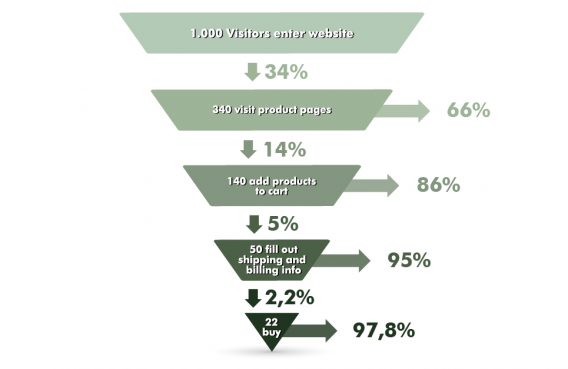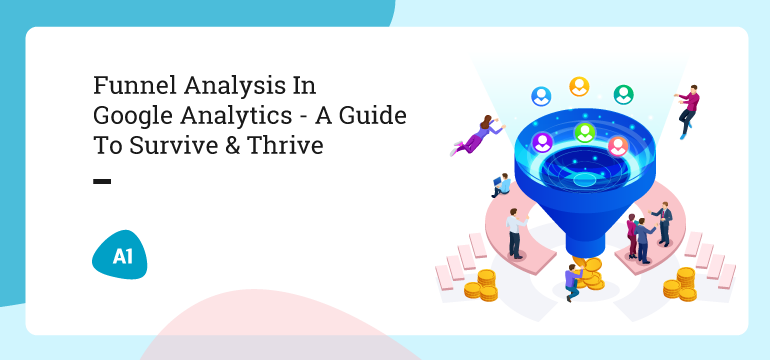The method of funnel analysis is crucial for getting to know the steps needed for reaching a decision for sales by determining how many users can get through the layout. These steps together make up for a funnel as they are typically envisioned as ones found in kitchens and garages. The funnel bylines the processes of checking in, registration, lead generation, checking out and many other things that the customers take towards making a sales decision.
Where do funnels occur?
The very 1st example would be the splash page, followed by demo & sign up. Although, this entire flow depends on the type of business you are dealing in. The funnel formation is figured out by companies through their customized strategies.
While analyzing the funnel, you ought to find many different things:
- The current conversion rates
- The current dropoff rates
Calculating the 1st one depends on the percentage of people is registering their details. Dropoff rates are always lower than it. It is the thumb rule to lose a chunk of people at every step of the funnel. The front page of any website must not be pushy to the visitors and force them to sign up. A lot of leads are lost in this way before they even make it to the next step. Companies also lose a good chunk of points on their downloads page where they just decide not to continue. It is very much crucial to figure out where 7 why you are losing them before you are on for any tweaking.
How does funnel analysis help?
When you track funnels, you will be able to change the strategies on the basis of the user behavior. You might just discover a page that has a 90% dropoff rate killing the opportunities of conversion.
How do you fix the dropoff?
Always approach the issue of fixing the dropoff rate by analyzing it from the users’ point of view. Identify the bottlenecks, the potholes and the elements that defer the seamless flow in the conversion funnel of your webpage. There is a possibility that you are missing out on considering what you want your users to do. The moment they decide to take the purchase decision, they get distracted other links of menu, ads & other such things. Remove those distractions from the critical points of the funnel so that the affirmative action is more comfortable to take.
Enter Google Analytics, helping you to locate the users where they quit. With this excellent funnel analysis tool, you can identify the points where the users abandon their carts. Let’s get into the details:
The initial setup of the conversion funnel is very much crucial. You have to create goals in the analytics for the purpose. To make that goal eligible for the funnel, it has to be a destination goal- i.e., a specific webpage has to be set as a goal which can be achieved with the visit of every user.
The best example for it is the page for an e-commerce website where the user lands with the ‘transaction confirmation’ page or ‘thank you’ page.
Once you are done with setting up of the destination goals in Google Analytics, the funnel visualization tool will serve you a report. See example below.

Image Source: CXL
Do ensure, before you are confident with the funnel visualization reports, refer with the exact pages that serve as the entry or starting point of the funnel. For e-commerce websites, product pages serve as the entry points for a funnel.
There can be other entry points as well like:
- Recommendation page
- Cart page
- Billing and shipping page
- Confirmation screen
- Thank you page
Regardless of what you choose to be your funnel’s entry point, the rest of the process is single-line. The customers have to be able to start a journey in the funnel through adding the product in the cart; otherwise, there will not be any sense.
How to create a marketing funnel: Google analytics goal flow for common goal-tracking issues
- The very 1st thing you can do is to look out for any technical errors. Somewhere on the website if there is an erroneous link for that final step, the visitors will be able to access it without even initiating for the checkout process. Here you will be able to notice a good chunk of users bottle-necking the final step with an equally large number of dropouts. Bar the backdoor from the step so that you receive more conversion from the step.
- You can have a page in the funnel that is omitted or unaccounted for. With Google funnel analysis that page can be easily spotted since it denotes where the customers have dropped out. This is, in fact, a straightforward process where you can find about the missing step easily from the Google analytics.
- Another standard error is that the buyers drop out of the final sect of the conversion funnel, but they return to the Thank You page at the same time. The phenomenon occurs when the website uses a payment gateway. Each time, the payment is initiated, they get navigated to the third-party site & on the completion of transaction, they get back to your webpage again. As a result, you end up getting a huge pool of analytics data.
The solutions to these issues are simple:
- While using a third-party payment gateway, you can add its URL to your referral exclusion list. In Google Analytics, go to admin, open property settings, open tracking info, fill in the referral exclusion field with the URL.
- Opt for a payment system that can easily integrate with your cart so that you have things by your side. Your funnel in this way will become foolproof through preserving the data integrity of Google Analytics. You will retain the needed perks from your third-party gateway in your website only and the customers do not have to move to their website for the same.

Reverse goal path funnel analysis in Google analytics
Before the next step of analysis, there is a final checkpoint which is known as the ‘reverse goal path.’ Once your conversion goal is defined, it is advised to wait a week or two for monitoring which pages people open before the goal is reached. If the funnel is correctly structured, the report will have no difference in expected outcomes.
How to carry out funnel analysis for data?
Once the funnel is set, some data is to be allowed to pass for some time maybe a week or two so that the information from analysis becomes available. This much time will suffice for tracking the traffic volume for building up valid conclusions. To draw in well-rounded results though, the custom funnels in Google analytics need a month to let a sales cycle baseline to be used for reference. The funnel signifies the visitor’s path right from the inclusion of product until the checkout point where the merchant provider charges them.
Here, the visitor needs to climb the following steps:
- Select a product from its exclusive page after customization
- Provide all contact and delivery information
- Validating the order and then initiating with the payment
Why you need to focus in these elements? Because these steps help in making out the basic source of funnel and friction dropouts and hence, solving issues for these spots show a good increase in the conversion rate. Check out in details as we discuss the steps below:
- The 1st step of any analysis funnel starts with the cart which experiences 75% abandonment (Source). Fixing this would definitely fetch an incredible amount of business to the venture. Providing proper product information, lucrative discounts to the 1st time users & other such benefits in exchange of the contact information.
- Shipping and billing poses as one of the biggest challenges of website credibility. Before delivering a product to the customer crucial details like phone number, credit or debit card number are asked and at that point, people leave their cart. To eliminate this unfortunate mishap, the users are to be provided with privacy and trust indicators like a small motif of anti-virus or malware protection company. Also, keep the option of Cash-on-Delivery available so that the new users can be confident about choosing your service.
- The dropout rate at the payment confirmation step is critical because the product price and the final price differ here. When the user sees a huge gap due to the added surprising elements, he or she does not think twice before abandoning it. Only providing the detailed pricing criteria is not enough; it is also important to keep the prices reasonable as well as logical.
Writing it off…
With these Google conversion funnel analysis steps identify the faults and drawbacks in your strategies. After a certain time, the same old tricks fail to work with the changing consumer preferences. Analytics can never precisely tell you why a user quits, but they can definitely tell you where the mishaps take place. In case, you lack the resources, choosing a professional branding agency will be of great help; from strategizing, implementing to tracking, the customized services will cover every aspect of the funnel’s functionality.




